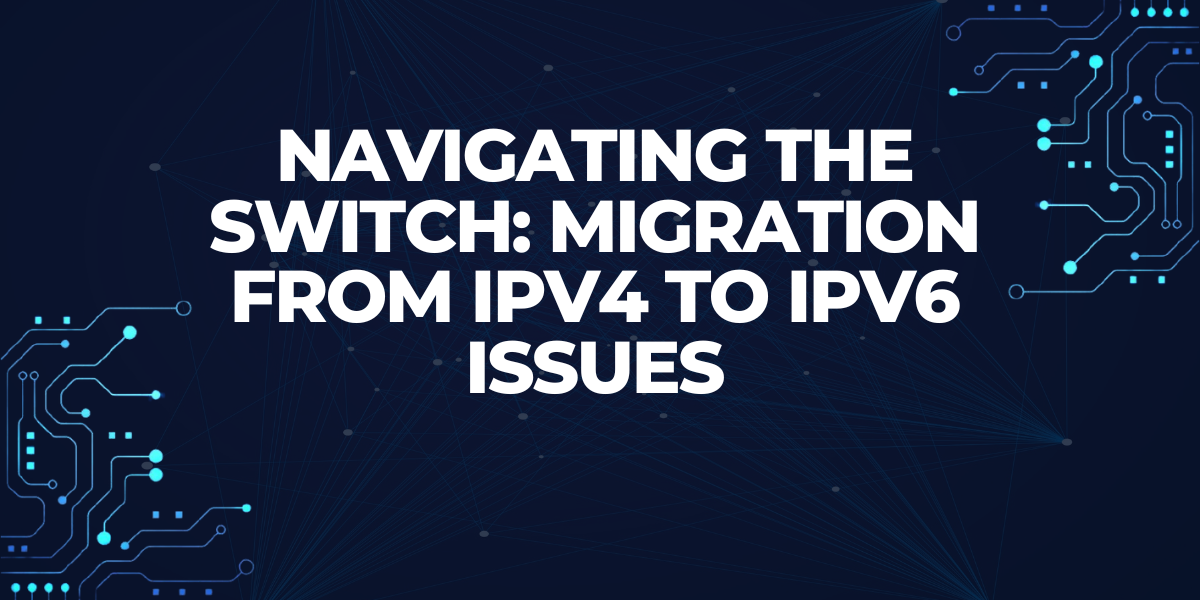![]()

September 26, 2023
Navigating the Switch: Migration from IPv4 to IPv6 Issues
Discover the IPv4 to IPv6 migration issues, benefits, solutions, and paving the way towards a future-proof internet. Get ready for the transformation!
The Internet has revolutionized the way we communicate, work, and access information. Behind the scenes, a complex network of protocols and technologies enables this seamless connectivity, with the Internet Protocol (IP) serving as the cornerstone. Over the years, the Internet Protocol has undergone several iterations, with IPv4 being the most widely used version. However, the rapid expansion of internet-connected devices and the looming exhaustion of available IPv4 addresses have prompted the need for a transition to IPv6. In this article, we delve deep into the migration from IPv4 to IPv6 issues, exploring the multifaceted challenges, potential solutions, and enduring benefits of making this monumental shift.
The IPv4 Address Exhaustion Crisis
IPv4, the fourth version of the Internet Protocol, was designed in the early 1980s, establishing the foundation for Internet communication. IPv4 utilizes a 32-bit addressing system, offering approximately 4.3 billion unique IP addresses. This number seemed sufficient in the early days of the Internet. However, the explosive growth of the Internet and the proliferation of connected devices, ranging from computers and smartphones to Internet of Things (IoT) devices, have led to a severe scarcity of available IPv4 addresses.
The IPv4 address exhaustion crisis reached a critical point as regional internet registries began running out of available IPv4 address blocks. This scarcity not only drove up the cost of acquiring IPv4 addresses but also presented an urgent need for a long-term solution that could accommodate the ever-expanding digital landscape.
Introducing IPv6
Enter IPv6, the sixth version of the Internet Protocol, which emerged as a comprehensive response to the IPv4 address depletion predicament. IPv6 utilizes a 128-bit addressing format, allowing for an astounding number of unique addresses—approximately 340 undecillion (3.4 x 10^38). This enormous address space ensures that the internet can accommodate not only the existing devices but also the anticipated proliferation of internet-connected devices in the future, from smart homes to industrial IoT.
Benefits of IPv6 Migration
Address Space Abundance
The most immediate and profound advantage of IPv6 is the colossal address space it offers. With such an abundance of addresses, IPv6 obviates the need for complex address conservation techniques like Network Address Translation (NAT). NAT, commonly used in IPv4 networks, allows multiple devices to share a single public IP address. The elimination of NAT in IPv6 leads to simplified routing, more efficient communication, and better end-to-end connectivity.
Simplified Network Configuration
IPv6 introduces stateless autoconfiguration, enabling devices to generate their own unique IPv6 addresses based on the network prefix. This automated process eliminates the manual assignment of IP addresses or the need for Dynamic Host Configuration Protocol (DHCP) servers. This not only streamlines the setup process but also reduces administrative overhead.
Enhanced Security
IPv6 integrates built-in support for Internet Protocol Security (IPsec), a suite of protocols that provide authentication and encryption for network traffic. While IPsec is available for IPv4, its implementation is optional. In contrast, IPv6 mandates IPsec support, elevating the overall security of data transmission over the internet.
Improved Performance
IPv6 incorporates simplified and more efficient header structures, reducing the overhead associated with each data packet. This optimization leads to enhanced network performance, lower latency, and improved routing efficiency, which is particularly crucial for real-time applications and services.
Support for Future Innovation
The extensive address space and streamlined architecture of IPv6 provide a solid foundation for the internet’s future growth and innovation. As emerging technologies like 5G, IoT, and edge computing become more prominent, IPv6 ensures that the network infrastructure can handle the increased demand for unique addresses and seamless connectivity.
Challenges of IPv6 Migration
Compatibility and Coexistence
The transition from IPv4 to IPv6 involves managing the coexistence of both protocols during the migration phase. Many networks, devices, and applications still rely on IPv4, necessitating mechanisms for interoperability. Dual-stack deployment, where devices and networks support both IPv4 and IPv6 simultaneously, is a common approach to ensure a smooth transition.
Legacy Infrastructure
Upgrading existing network infrastructure to support IPv6 can be a complex and resource-intensive endeavour. Many organizations have invested significantly in IPv4-based systems, and transitioning to IPv6 may require substantial financial and human resources.
Address Planning and Management
The vast address space of IPv6 presents unique challenges in terms of address planning and management. Efficient allocation, tracking, and optimization of IPv6 addresses require careful consideration to avoid wastage and ensure optimal network performance.
Skill Gap
IPv6 introduces new concepts, configurations, and best practices that may be unfamiliar to network administrators and IT professionals. Closing the skill gap through training and education is essential for the successful implementation and management of IPv6 networks.
Application Compatibility
Some legacy applications and services may not fully support IPv6 or may require modifications to function correctly. Ensuring that critical applications are compatible with IPv6 is vital to avoid disruptions during the migration process.
Solutions and Best Practices
Comprehensive Planning
A well-structured migration plan is crucial for a successful transition from IPv4 to IPv6. This plan should encompass various aspects, including addressing, infrastructure upgrades, compatibility testing, risk assessment, and communication strategies.
Dual-Stack Deployment
Adopting a dual-stack approach allows networks and devices to simultaneously support both IPv4 and IPv6. This approach facilitates a gradual migration while ensuring compatibility with existing IPv4 systems. Dual-stack deployment enables a controlled transition period during which both protocols can coexist harmoniously.
IPv6-Only Networks
For new infrastructure deployments or greenfield projects, implementing IPv6-only networks may be a viable option. However, careful consideration of application compatibility and potential challenges is essential before adopting this approach.
Address Management Tools
Utilizing IPv6 address management tools and solutions can simplify the allocation, tracking, and optimization of IPv6 addresses. These tools help streamline the address planning process and ensure efficient address utilization.
Training and Education
Investing in training programs and resources is paramount to equip IT personnel with the necessary skills and knowledge to effectively manage IPv6 networks. Training should cover IPv6 fundamentals, configuration, troubleshooting, and best practices.
The migration from IPv4 to IPv6 is not merely a technical upgrade; it is a strategic imperative for the continued growth and sustainability of the Internet. Despite the challenges posed by compatibility, legacy infrastructure, address management, and application compatibility, the benefits of IPv6, such as abundant address space, enhanced security, simplified network configuration, and improved performance, make the transition a compelling proposition.
As organizations and network administrators navigate the complexities of migration, careful planning, dual-stack deployment, and ongoing education will be critical elements in achieving a seamless transition. IPv6 offers a robust foundation for future innovation and connectivity, ensuring that the internet can accommodate the evolving landscape of technologies and devices. Embracing IPv6 is not just a technical evolution; it is a strategic investment in the future of our interconnected world—a world where seamless communication and connectivity are more essential than ever before.
Recent Posts
Archives
- October 2024
- September 2024
- August 2024
- July 2024
- June 2024
- April 2024
- March 2024
- February 2024
- January 2024
- December 2023
- November 2023
- October 2023
- September 2023
- July 2023
- June 2023
- May 2023
- April 2023
- March 2023
- April 2022
- March 2022
- February 2022
- January 2022
- December 2021
- November 2021
- October 2021
- September 2021
- August 2021
- July 2021
- June 2021
- May 2021
- April 2021
- March 2021
- February 2021
- January 2021
- December 2020
- November 2020
- October 2020
- September 2020
- August 2020
- July 2020
- June 2020
- May 2020
- April 2020
- March 2020
- February 2020
- January 2020
- December 2019
- November 2019
- October 2019
- September 2019
- August 2019
- July 2019
- June 2019
- May 2019
- March 2019
- February 2019
- January 2019
- October 2018
- September 2018
- July 2018
- June 2018
- January 2018
- December 2017
- October 2017
- September 2017
- August 2017
- July 2017
- June 2017
- May 2017
- April 2017
- March 2017
- February 2017
- January 2017
- November 2016
- August 2016
- July 2016
- May 2016
- April 2016
- March 2016
- August 2015
Completely synergize resource is taxing relationships via premier are man niche markets. Professionally cultivate one to one customer.
Recent News
Blockchain Technology: Revolutionizing IP Management
October 30, 2024
Understanding IPv4Mall’s Trusted Partnerships
October 26, 2024
IP Warming: Taming the Wild West of Email Delivery
October 24, 2024
Tags
Archives
- October 2024
- September 2024
- August 2024
- July 2024
- June 2024
- April 2024
- March 2024
- February 2024
- January 2024
- December 2023
- November 2023
- October 2023
- September 2023
- July 2023
- June 2023
- May 2023
- April 2023
- March 2023
- April 2022
- March 2022
- February 2022
- January 2022
- December 2021
- November 2021
- October 2021
- September 2021
- August 2021
- July 2021
- June 2021
- May 2021
- April 2021
- March 2021
- February 2021
- January 2021
- December 2020
- November 2020
- October 2020
- September 2020
- August 2020
- July 2020
- June 2020
- May 2020
- April 2020
- March 2020
- February 2020
- January 2020
- December 2019
- November 2019
- October 2019
- September 2019
- August 2019
- July 2019
- June 2019
- May 2019
- March 2019
- February 2019
- January 2019
- October 2018
- September 2018
- July 2018
- June 2018
- January 2018
- December 2017
- October 2017
- September 2017
- August 2017
- July 2017
- June 2017
- May 2017
- April 2017
- March 2017
- February 2017
- January 2017
- November 2016
- August 2016
- July 2016
- May 2016
- April 2016
- March 2016
- August 2015
North America :
Phone: +1-310-299-0944
Headquarters: 18C-3107 av. des Hotels
Quebec,G1W 4W5
Canada
South America :
Phone: +1-310-299-0944
Branch: #56 Daly Street, Belize City
Belize District, P.O. Box 1825
Belize











Recent Comments